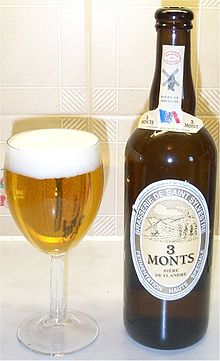Bière de garde
Bière de garde refers to a top-fermented type of beer from the French region of Hauts-de-France . These beers can be light or amber in color ( ambrée ) and have an alcohol content of over 6%.
Origin of name and manufacturing process
The name of this type of beer can cause confusion among German-speaking consumers. Literally translated, bière de garde means “beer to keep”. Originally the bières de garde were brewed in farmhouses in northern France. This traditionally happened at the end of spring. After fermentation, the top-fermented beer was stored in barrels in cool beer cellars for a long time. The French term garde means storage. Nowadays the beer is stored in storage tanks at cold temperatures. The longer storage time creates other fermentation by-products and the beer matures slowly. Sugar and yeast refine the character of the beer during the garde and increase the alcohol content. Traditionally, there was sometimes a second fermentation in the bottle and this in champagne-type bottles. Bottle fermentation is rather the exception these days, but beer is still filled in champagne bottles with corks. The bière de garde is traditionally fermented top- fermented, but there are also bottom-fermented beers.
The bière de garde was reborn in the 1970s
In the 1970s, the traditional northern French bière de garde had almost been forgotten. Many French breweries, also in Nord-Pas-de-Calais, were about to adopt the fashion of standardized bottom-fermented lager beers and the old regional specialties had become a niche product. The Brasserie Duyck in Jenlain, a small village in the French Hainaut near Valenciennes ( Département Nord ) has done a lot for the rebirth of the traditional top-fermented beer. The family brewery in Jenlain has been brewing top-fermented beer since the beginning of the 20th century, which was stored in barrels before being bottled.
In 1922, champagne bottles were reused for beer. This allowed the beer to mature longer in the bottle and the fermentation process was also prolonged due to the yeast's work. The beer refined in the bottle. The Duyck brewery sold the beer as Vieille Bière (old beer). After the Second World War it was marketed as a bière de garde . In 1968 the beer was renamed, which now bears the name of the village in which the brewery is located; Jenlain .
In the 1970s, when bottom-fermented light beers were being promoted in France and throughout Europe, students from Lille discovered the top-fermented amber-colored Jenlain Ambrée . The beer from the Duyck brewery became a cult beer. In order to follow the triumphant advance of the Jenlain , other breweries in the region also switched to the traditionally top-fermented bières de garde . The rediscovery of the top-fermented bière de garde in northern France happened around the same time as the rebirth of the classic real ale in Great Britain.
In 1978, the Brasserie Castelain family brewery in Bénifontaine , near Lens , in the Pas-de-Calais department, brewed the light, top-fermented bière de garde "Ch'ti blonde". Nowadays, several breweries brew the bière de garde in the Nord-Pas-de-Calais region, where it is considered a regional specialty. The breweries that brew traditional top-fermented beer tend to be small or medium-sized companies, private breweries or family breweries. Well-known representatives of this type of beer are Jenlain Ambrée and Jenlain Blonde ( Brasserie Duyck ), Ch'ti Blonde , Ch'ti Ambrée (Brasserie Castelain), Trois Monts ( Brasserie de Saint-Sylvestre ) ...
taste
The bières de garde have a strong, malty character and are not very hopped.
literature
- Adrian Tierney-Jones (Ed.): Les 1001 bières qu'il faut avoir goûtées dans sa vie . Flammarion, Paris 2012.
